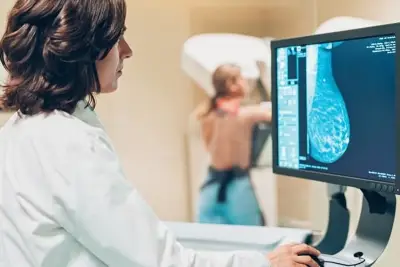Is a lump in your breast always a sign of breast cancer?

A mammogram screening in process File photo courtesy of the CDC Insufficient things are more unsettling for a woman than discovering a lump in her breast It s natural for the experience to trigger worry or anxiety even fear Although breast cancer may be your first thought it s fundamental to know that a breast lump doesn t necessarily mean you have cancer Interestingly several breast cancers don t form a lump making both routine screening mammograms and breast self-awareness crucial This includes familiarizing yourself with the normal look and feel of your breasts to spot any changes early and seeing your wellness care provider if something seems off What to watch for According to the American Cancer Society breast cancer accounts for about of all new cancers in women each year The average woman s lifetime threat of evolving breast cancer in the U S is roughly in the chance of dying from it is about in While finding a lump should prompt a visit with your healthcare provider there are also other manifestations to be aware of While greater part early-stage breast cancers present with no characteristics at all it is pivotal to be aware that particular breast cancers can present with findings other than a palpable lump Features to watch for and analysis to a soundness care provider include Breast pain or feeling of fullness in the breast or axilla Nipple discharge Itching of the skin Dimpling or puckering of the skin Changes in the symmetry of the breasts Other causes of lumps There are several reasons why a breast lump may appear If you do find a lump don t panic be proactive Make an appointment to see your wellbeing care provider for further assessment It is also fundamental to keep in mind that largest part breast lumps are not associated with breast cancer This is particularly true of breast lumps detected in younger pre-menopausal women While any new breast lump should be evaluated the majority of palpable masses are associated with benign ailment The following are five common noncancerous or benign causes of breast lumps Fibroadenomas These smooth rubbery lumps move easily under your skin They may shrink or grow over time with changes often linked to pregnancy hormone therapy or menstruation Cysts These fluid-filled sacs may feel round smooth and firm Varying in size they can cause tenderness especially in the days leading up to menstruation A cyst is more noticeable and tender around your menstrual cycle and may change in size or disappear after a period Fibrocystic breast changes This condition can cause areas of your breast tissue to feel lumpy or rope-like especially during menstruation Manifestations often improve after a period ends Infections or abscesses A collection of infected fluid may build up and cause an abscess in your breast tissue or a breast lump It s often accompanied by redness warmth and swelling caused by the infection Injury or trauma A breast lump can sometimes upshot from a direct injury or trauma to the breast leading to fat necrosis a condition where damaged fatty tissue forms a firm lump While multiple breast lumps are not cancerous regular mammogram screenings and paying attention to changes in your breasts are the best procedures to catch cancer or anything else abnormal early Additionally timely detection makes recovery more likely to be effective If you find a lump don t wait talk with your clinician Dr Kelly DeWitt is a board-certified radiation oncologist with Sharp Public Health Group and affiliated with Sharp Grossmont Hospital


